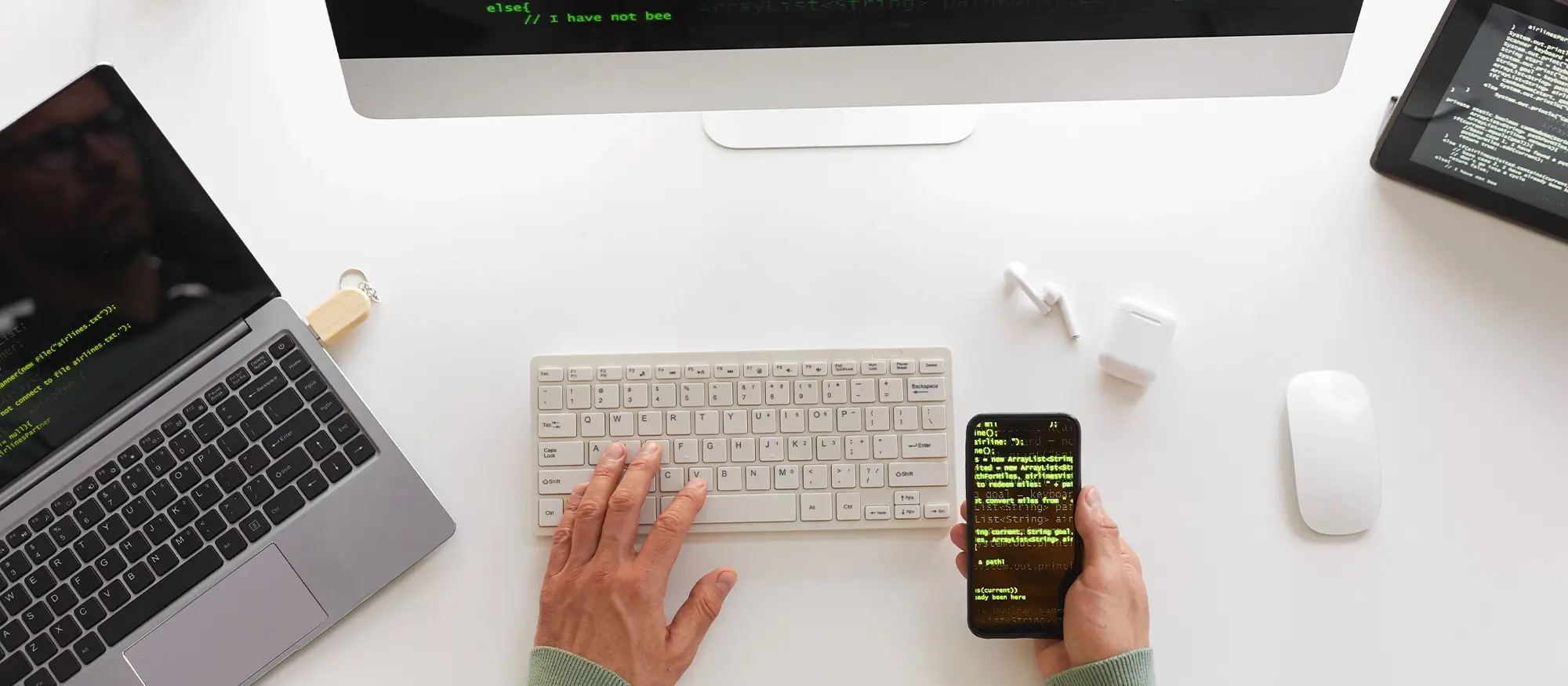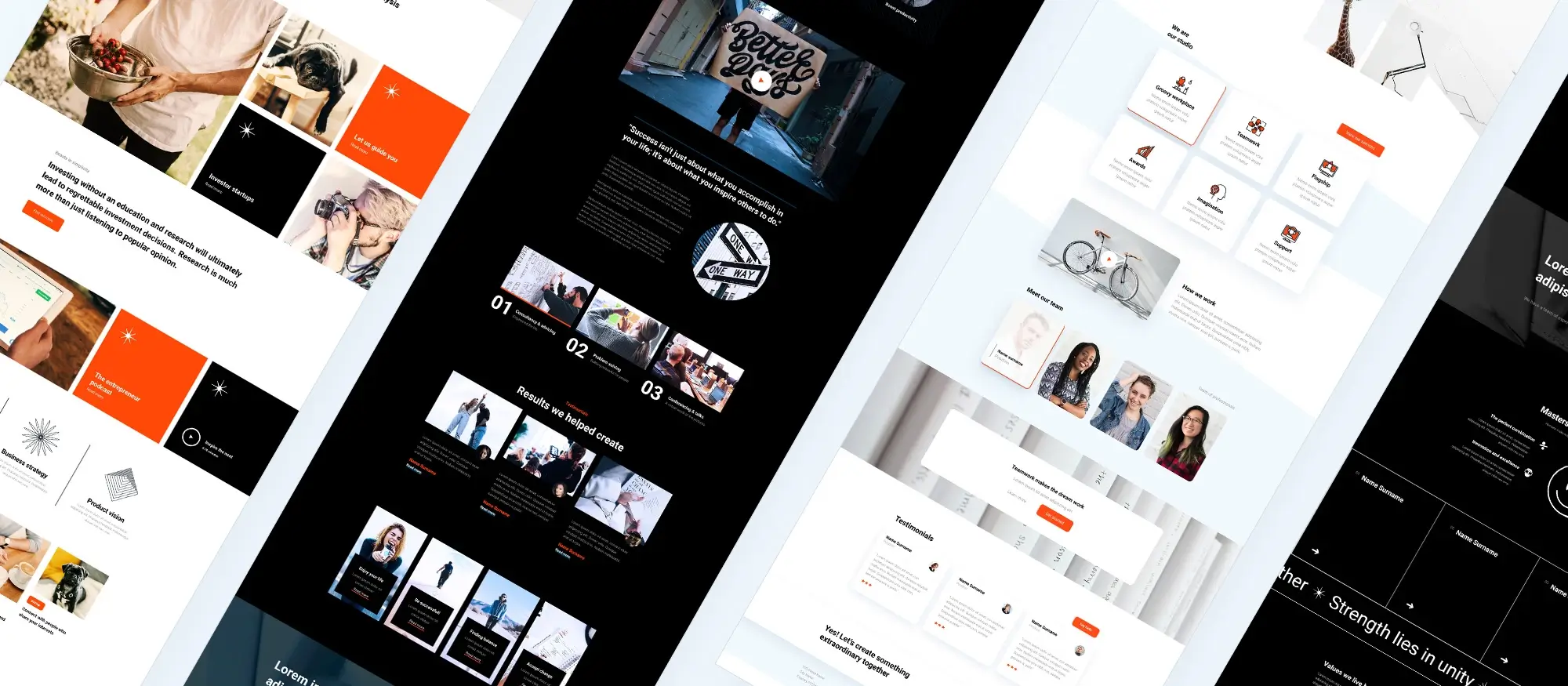WordPress responsive design: Mobile-friendly websites
Try MaxiBlocks for free with 500+ library assets including basic templates. No account required. Free WordPress page builder, theme and updates included.

Updated 15th May 2025
Understanding WordPress responsive design
Why mobile-friendly design matters more than ever
With more people browsing the internet on smartphones and tablets, having a mobile-friendly website is no longer optional. Responsive WordPress website design makes sure your site looks good and works well on all types of devices, from large desktop screens to small mobile phones. A site that adjusts properly to different screen sizes offers a better user experience, which keeps visitors engaged for longer and helps your site perform better in search engines.
WordPress offers strong support for responsive design, making it easier for site owners and designers to create websites that are attractive and fully functional on any device. Whether you are starting a new website or updating an existing one, focusing on responsive design is essential to stay competitive and reach a wider audience.
How WordPress responsive design works
Responsive design in WordPress is all about flexibility. Instead of building different versions of a site for each device, one flexible layout adjusts itself depending on the screen size. The main principles behind responsive design include fluid grids that scale content proportionally, flexible images that resize within their containing elements, and media queries that apply different styling rules based on the device’s characteristics.
Using these principles ensures that your website remains usable and visually appealing across a wide range of devices. It improves usability for visitors and can also have a positive impact on SEO, as search engines favour sites that provide a good experience for mobile users.
Choosing the right responsive WordPress theme
When building a mobile-friendly site, picking the right theme is crucial. Not every theme is truly responsive, so it is important to choose one that is designed with mobile devices in mind. Themes like MaxiBlocks, GeneratePress and OceanWP are excellent examples of WordPress themes built for responsiveness. They automatically adjust layouts, images and navigation to suit different screens without any extra work from you.
Before settling on a theme, it is a good idea to test how it performs. You can preview the theme on different devices or use browser tools to simulate various screen sizes. This helps you check that the layout adapts smoothly, that the text remains readable and that navigation stays easy to use.
Choosing a responsive theme from the start saves time and effort later. It means your website will be ready to meet the expectations of today’s mobile-first audience and give visitors a positive experience no matter how they access your site.

Customising your WordPress theme for mobile
How to make your site mobile-friendly using the WordPress Customizer
The WordPress Customizer is a powerful tool for adjusting your theme’s settings to make sure your website looks and works well on mobiles. Focus first on simplifying navigation so it is easy for users to move around the site with their thumbs. Adjust the layout so that important information appears near the top of the screen and ensure that text is large enough to read comfortably on smaller devices.
Spacing is also important. Proper padding and margins make your content easier to read and navigate without feeling cramped. By tweaking these elements, you can create a cleaner, more enjoyable experience for mobile visitors.
Plugins and tools to improve mobile responsiveness
There are several WordPress plugins that can help boost your site’s mobile performance. Free options like WPtouch and Jetpack offer tools to improve usability for mobile users without needing to make major changes to your site.
It is also a good idea to test your site regularly using tools like the Google Mobile-Friendly Test or BrowserStack. These tools help you spot any problems that might affect the mobile experience and suggest ways to fix them.
Best practices for creating mobile-friendly content
Content needs to be adapted for mobile users. Keep paragraphs short and make use of bullet points to break up information and make it easier to scan. Aim for fast loading times by optimising images and videos with the right formats and sizes.
Mobile users often have less patience for slow or confusing pages. Keeping things simple and to the point will help keep visitors interested and engaged.
How to test your site’s mobile responsiveness
Testing your site regularly is crucial to keeping it responsive and user-friendly. Cross-browser testing tools can show you how your site looks and works across different browsers and devices. Browser developer tools also allow you to simulate various screen sizes and check for problems.
It is a good idea to gather feedback from real users too. Sometimes issues only become obvious once people start using the site on their own devices in real-world conditions.
Using custom CSS for better mobile design
If you want more control over how your site behaves on different devices, custom CSS can help. Using media queries in CSS, you can apply different styles depending on the screen width. For example, you can hide certain elements on small screens, adjust layouts, or change font sizes to improve readability.
Fine-tuning your design with custom CSS ensures that your site remains consistent and user-friendly across all screen sizes.
Advanced techniques for responsive WordPress design
For those looking to take responsive design further, frameworks like Bootstrap and Foundation offer built-in features that make it easier to create mobile-friendly sites. These tools provide flexible grids, responsive typography and ready-made elements that adapt well to different screen sizes.
Making forms and interactive elements responsive is also important. Mobile users need forms that are easy to fill out without zooming or scrolling sideways. Paying attention to small details like this can significantly improve the overall experience and help your site feel polished and professional on every device.
Subscribe to our newsletter
Ensuring ongoing responsiveness for your WordPress site
Keeping your WordPress site responsive over time
Keeping your WordPress site responsive is not a one-time task. It requires regular updates and monitoring to make sure it continues to perform well on all devices. Updating WordPress, your theme and any plugins you use is important for maintaining good performance and security.
It is also helpful to monitor your site’s mobile performance using analytics and testing tools. These can show you if users are having problems on certain devices or if parts of your site are not loading properly. Staying informed about the latest trends in responsive design can help you spot opportunities to improve your site and keep it competitive.
How to approach responsive design in WordPress
When starting out with responsive design, the first step is to choose a theme that is built to be responsive. This saves a lot of time and effort right from the beginning. Once your theme is in place, use the WordPress Customizer to make adjustments to layout, text sizes and spacing to make sure everything works well on smaller screens.
Plugins like WPtouch and Jetpack can add extra features that help with mobile usability. However, it is important not to rely only on plugins. Regular testing using tools and custom CSS tweaks will give you greater control and allow you to fine-tune the mobile experience.
Using advanced frameworks like Bootstrap or Foundation can provide more flexibility if your site has more complex design needs. These tools offer built-in responsive elements that help your site adjust smoothly across different devices.
Ongoing maintenance is essential. Regular checks and small updates will make sure your site stays responsive as new devices and screen sizes come onto the market.
How to make a WordPress website mobile-friendly
To make your WordPress site mobile-friendly, begin by selecting a responsive theme. This lays a strong foundation for a site that adapts easily to different screen sizes. Plugins such as WPtouch and Jetpack can help with mobile optimisation, but make sure to keep an eye on how your site actually performs on phones and tablets.
Optimising content for mobile viewing is just as important. Use short paragraphs, clear headings and optimised images to make your site easy to read and navigate on smaller screens. Regular testing is key. Use browser developer tools, testing websites and feedback from real users to spot issues early.
Using custom CSS and media queries gives you even more control. You can make layout adjustments, change font sizes or even hide certain elements on small screens to improve the mobile experience. There are also mobile-specific tools and plugins available that help fine-tune your design and keep everything running smoothly.
By combining smart theme selection, careful content planning, regular testing and ongoing updates, you can make sure your WordPress site stays mobile-friendly and delivers a great experience to all visitors.

How to make sure a website is responsive and mobile-friendly
Key steps to building a mobile-friendly WordPress website
Making sure your website is responsive starts with choosing the right theme. A theme designed to be mobile-friendly will automatically adjust layouts, images and navigation to fit different screen sizes. Once the theme is set up, use the WordPress Customizer to fine-tune the design for mobiles, making sure text is easy to read and navigation is simple to use.
Responsive plugins can help improve your site further. Regular testing is essential. Tools like the Google Mobile-Friendly Test allow you to quickly check how your site performs on phones and tablets. If problems are found, custom CSS adjustments can be used to fix layout issues or improve readability.
By staying on top of these steps, you can make sure your website offers a consistent, mobile-friendly experience for all users.
Simple ways to improve your mobile site experience
To optimise your WordPress site for mobiles, start by selecting a responsive theme that adapts well to different screen sizes. Use mobile-friendly plugins that help with navigation, speed and performance. Adjust your site’s design in the WordPress Customizer, making changes to font sizes, layout and spacing so that everything is easy to read and use on smaller screens.
Compressing images is another important step. Smaller file sizes help your pages load faster, which is crucial for keeping mobile users engaged. Try to minimise load times by keeping your site’s code clean and avoiding too many heavy features.
Always test your site regularly across a range of devices and browsers. Small issues can appear as technology changes, so ongoing testing ensures a smooth experience for every visitor.
Free plugins that improve your site’s mobile performance
If you want to improve your site’s mobile performance without spending money, there are several good plugin options. WPtouch is a popular free plugin that automatically adds a simple and clean mobile theme to your WordPress site. It is easy to set up and helps make your site more usable on smartphones and tablets.
Jetpack is another free plugin that offers a range of tools for mobile optimisation, including performance improvements, image optimisation and site security. Both WPtouch and Jetpack can significantly improve your site’s mobile friendliness without any extra cost.
Best plugins for boosting mobile responsiveness
When it comes to making your WordPress site more responsive, plugins like WPtouch and Jetpack stand out. WPtouch focuses on providing a lightweight, mobile-friendly theme that automatically adjusts your site’s content for smaller screens.
Jetpack offers a wider set of tools, including mobile theme support, image compression and performance optimisation, all of which contribute to a better mobile experience.
Both plugins are easy to install and configure, making them excellent choices if you want to quickly and effectively improve your site’s usability on mobile devices. Regular updates and testing alongside these plugins ensure your site stays responsive and ready for all types of visitors.
Build like a pro
Making your WordPress site responsive and mobile-friendly
Tools and plugins to boost mobile performance
Several plugins can help make your WordPress site more responsive. WPtouch and Jetpack are two popular choices that improve mobile usability without needing much technical knowledge. If you are looking for more control, page builders like Elementor and WPBakery offer advanced options. These allow you to adjust layouts, tweak elements and fine-tune how your site looks and works on mobiles and tablets.
Editing the mobile version without affecting the desktop
You can edit the mobile version of your WordPress site separately by using custom CSS with media queries. This method lets you apply styles just for smaller screens while keeping your desktop layout untouched. Page builders like Elementor make this process simpler by letting you switch views between desktop, tablet and mobile, so you can customise each one easily.
Choosing the right mobile-friendly theme
Picking a theme designed for mobile devices is an important first step. Themes like Astra, GeneratePress and OceanWP are excellent choices. They are built with responsiveness in mind, meaning they adapt smoothly to different screen sizes and give you settings that make it easy to create a good experience for mobile users.
How to build a responsive website in WordPress
Start by choosing a responsive theme and customise it carefully using the WordPress Customizer. Use plugins like WPtouch or Jetpack to add extra mobile features, and make sure your content is easy to read on smaller screens. Compress images and keep your page load times fast. Regular testing and small adjustments with custom CSS will keep your site responsive as technology and user habits change.
Editing only the mobile view
When you need to make changes just for mobile, custom CSS with media queries is one way to do it. You can hide or adjust elements depending on the screen size. Tools like Elementor also let you edit the mobile version of a page separately, giving you precise control over how your site looks on different devices.
Solving mobile view problems
If your WordPress site does not display properly on mobile, start by running it through testing tools like Google’s Mobile-Friendly Test. Common issues often come from theme settings, CSS conflicts or plugin problems. Carefully check and adjust your theme’s mobile settings and use custom CSS if needed to fix layout problems. Regular testing helps you catch issues early and ensures your site stays smooth and user-friendly on any device.

Final thoughts on WordPress responsive design
These days, if your website doesn’t work properly on a mobile phone, you’re already losing out. More people are browsing the web on their phones than on laptops or desktops, so making sure your WordPress site looks good on any screen is absolutely vital.
Responsive design simply means that your website adjusts itself depending on the device someone’s using. Whether it’s a mobile, a tablet or a big desktop monitor, a properly responsive WordPress site will always look clean, tidy, and easy to use. Themes like Astra and GeneratePress have built their reputations on being lightweight and fully responsive right out of the box, making life a lot easier for site owners.
Luckily, WordPress itself is very much built with responsive design in mind. Most modern themes are already mobile-friendly, and builders like MaxiBlocks and Elementor let you tweak how your site looks on different screen sizes without having to touch a line of code. Even better, with tools like the WordPress block editor (also known as Gutenberg), you can quickly build pages that adjust nicely no matter what device people are using.
But it’s not just about looks. Google now uses mobile-first indexing, meaning it looks at the mobile version of your site first when deciding where to rank you in search results. So, if your site’s clunky or broken on mobile, you could be missing out on valuable traffic without even knowing it. Google’s mobile-friendly test is a handy tool you can use to quickly check how your site stacks up.
In the end, responsive design isn’t just a ‘nice-to-have’ it’s essential. WordPress gives you all the tools you need to make a responsive site, but it’s up to you to choose a good theme, check how your pages look on different devices, and make sure your visitors have a smooth experience, no matter how they find you.
In today’s digital landscape, ensuring your website looks great and functions seamlessly across all devices is non-negotiable. That’s where WordPress responsive design comes in. Whether you’re starting with WordPress website design tutorials or implementing more advanced WordPress design and development techniques, responsiveness should be a priority from the beginning. For small businesses, the WordPress website design for small business guide helps you tailor layouts to mobile users without sacrificing desktop appeal. Pair that with proven WordPress website design tips and a user-first approach to optimising user experience, and you’re already ahead.
If you’re unsure where to begin, studying examples from WordPress website designs and the best WordPress website designs can provide design inspiration. Or, for a more hands-on approach, consider using MaxiBlocks, which offers a visual builder ideal for creating responsive layouts. Not sure which tools to use? The WordPress guide to choosing a block addon can help you make informed decisions. And if you’re wondering how do I design my own WordPress website, or looking for a skilled WordPress website designer, these resources will guide you through the process with ease.
Inspiring WordPress designs for any type of site
Explore creative WordPress designs that balance style, performance, and usability.
FAQs – WordPress Responsive design
What is WordPress responsive design?
WordPress responsive design refers to creating a website that automatically adjusts and looks good on all devices, including desktops, tablets and smartphones. A responsive WordPress site ensures that content, images and layout elements scale properly to provide an optimal user experience on any screen size.
Why is responsive design important for WordPress websites?
Responsive design is important because most users access websites through mobile devices. A responsive WordPress site improves user engagement, reduces bounce rates, and helps with search engine rankings, as mobile friendliness is a ranking factor for Google.
Do WordPress themes come with responsive design?
Most modern WordPress themes are built to be fully responsive by default. When choosing a theme, it is important to check if it is labelled as mobile-friendly or responsive to ensure it adapts well to different devices.
How can I test if my WordPress site is responsive?
You can test your site’s responsiveness by resizing your browser window, using developer tools in your browser or checking your site on multiple devices. Online tools like Google’s Mobile-Friendly Test can also provide detailed feedback.
Can I make a non-responsive WordPress theme responsive?
It is possible but may require custom CSS, theme modifications or using a child theme. In some cases, it may be easier and more efficient to switch to a modern responsive theme rather than trying to fix an outdated one.
What tools help create responsive designs in WordPress?
The WordPress block editor, page builders like Elementor and Divi, and responsive frameworks like Bootstrap can help create layouts that adapt to different screen sizes without needing extensive coding.
How do images affect responsive design?
Using properly sized and optimised images is essential for responsive design. WordPress automatically creates different image sizes during upload, and themes can serve the appropriate size for different devices to improve loading times and visual quality.
Can I control how my site looks on mobile devices in WordPress?
Yes, many themes and page builders offer mobile editing tools that let you adjust padding, margins, font sizes and layout settings specifically for mobile devices to fine-tune the appearance on smaller screens.
Is responsive design the same as mobile-first design?
They are related but different. Responsive design adapts to all screen sizes, while mobile-first design focuses on designing for mobile devices first and then scaling up for larger screens. Many modern WordPress themes now follow a mobile-first approach.
Does responsive design affect website performance?
Yes, a well-executed responsive design improves performance by ensuring fast loading on mobile devices and reducing unnecessary resource usage. Optimising images, minimising code and using efficient layouts all contribute to a better responsive experience.
WordPress itself
Official Website
wordpress.org – This is the official website for WordPress, where you can download the software, find documentation, and learn more about using it.
WordPress Codex
codex.wordpress.org/Main_Page – This is a comprehensive documentation resource for WordPress, covering everything from installation and configuration to specific functionality and troubleshooting.
WordPress Theme Directory
wordpress.org/themes – The official WordPress theme directory is a great place to find free and premium WordPress themes. You can browse themes by category, feature, and popularity.
maxiblocks.com/go/help-desk
maxiblocks.com/pro-library
www.youtube.com/@maxiblocks
twitter.com/maxiblocks
linkedin.com/company/maxi-blocks
github.com/orgs/maxi-blocks
wordpress.org/plugins/maxi-blocks

Kyra Pieterse
Author
Kyra is the co-founder and creative lead of MaxiBlocks, an open-source page builder for WordPress Gutenberg.
You may also like

